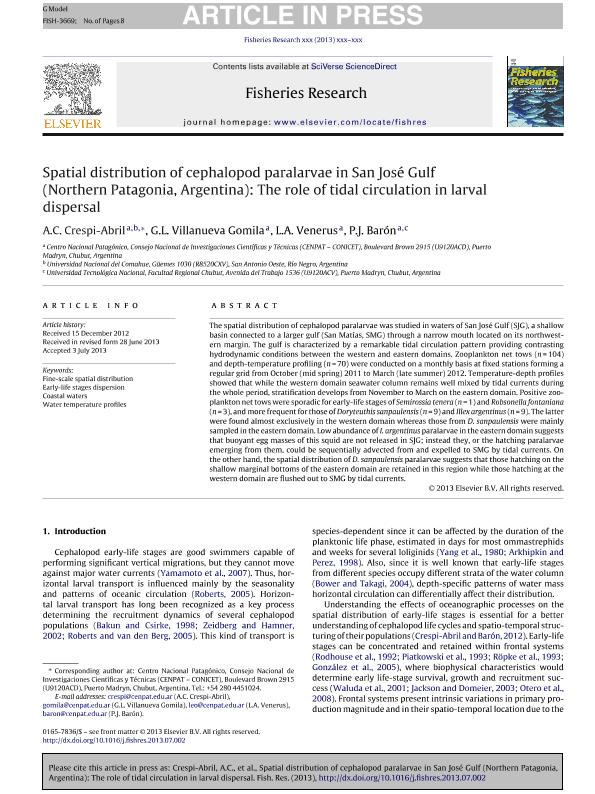Mostrar el registro sencillo del ítem
dc.contributor.author
Crespi Abril, Augusto Cesar

dc.contributor.author
Villanueva Gomila, Gabriela Lujan

dc.contributor.author
Venerus, Leonardo Ariel

dc.contributor.author
Baron, Pedro Jose

dc.date.available
2016-05-09T20:24:49Z
dc.date.issued
2013-07
dc.identifier.citation
Crespi Abril, Augusto Cesar; Villanueva Gomila, Gabriela Lujan; Venerus, Leonardo Ariel; Baron, Pedro Jose; Spatial distribution of cephalopod paralarvae in San José Gulf (Northern Patagonia, Argentina): The role of tidal circulation in larval dispersal; Elsevier; Fisheries Research; 152; 7-2013; 13-20
dc.identifier.issn
0165-7836
dc.identifier.uri
http://hdl.handle.net/11336/5588
dc.description.abstract
tThe spatial distribution of cephalopod paralarvae was studied in waters of San José Gulf (SJG), a shallowbasin connected to a larger gulf (San Matías, SMG) through a narrow mouth located on its northwest-ern margin. The gulf is characterized by a remarkable tidal circulation pattern providing contrastinghydrodynamic conditions between the western and eastern domains. Zooplankton net tows (n = 104)and depth-temperature profiling (n = 70) were conducted on a monthly basis at fixed stations forming aregular grid from October (mid spring) 2011 to March (late summer) 2012. Temperature-depth profilesshowed that while the western domain seawater column remains well mixed by tidal currents duringthe whole period, stratification develops from November to March on the eastern domain. Positive zoo-plankton net tows were sporadic for early-life stages of Semirossia tenera (n = 1) and Robsonella fontaniana(n = 3), and more frequent for those of Doryteuthis sanpaulensis (n = 9) and Illex argentinus (n = 9). The latterwere found almost exclusively in the western domain whereas those from D. sanpaulensis were mainlysampled in the eastern domain. Low abundance of I. argentinus paralarvae in the eastern domain suggeststhat buoyant egg masses of this squid are not released in SJG; instead they, or the hatching paralarvaeemerging from them, could be sequentially advected from and expelled to SMG by tidal currents. Onthe other hand, the spatial distribution of D. sanpaulensis paralarvae suggests that those hatching on theshallow marginal bottoms of the eastern domain are retained in this region while those hatching at thewestern domain are flushed out to SMG by tidal currents.
dc.format
application/pdf
dc.language.iso
eng
dc.publisher
Elsevier

dc.rights
info:eu-repo/semantics/openAccess
dc.rights.uri
https://creativecommons.org/licenses/by-nc-nd/2.5/ar/
dc.subject
Fine-Scale Spatial Distribution
dc.subject
Early Life-Stages Dispersion
dc.subject
Coastal Waters
dc.subject
Water Temperature Profiles
dc.subject.classification
Biología Marina, Limnología

dc.subject.classification
Ciencias Biológicas

dc.subject.classification
CIENCIAS NATURALES Y EXACTAS

dc.title
Spatial distribution of cephalopod paralarvae in San José Gulf (Northern Patagonia, Argentina): The role of tidal circulation in larval dispersal
dc.type
info:eu-repo/semantics/article
dc.type
info:ar-repo/semantics/artículo
dc.type
info:eu-repo/semantics/publishedVersion
dc.date.updated
2016-04-28T14:52:42Z
dc.journal.volume
152
dc.journal.pagination
13-20
dc.journal.pais
Países Bajos

dc.journal.ciudad
Amsterdam
dc.description.fil
Fil: Crespi Abril, Augusto Cesar. Consejo Nacional de Investigaciones Científicas y Técnicas. Centro Nacional Patagónico; Argentina. Universidad Nacional del Comahue; Argentina
dc.description.fil
Fil: Villanueva Gomila, Gabriela Lujan. Consejo Nacional de Investigaciones Científicas y Técnicas. Centro Nacional Patagónico; Argentina
dc.description.fil
Fil: Venerus, Leonardo Ariel. Consejo Nacional de Investigaciones Científicas y Técnicas. Centro Nacional Patagónico; Argentina
dc.description.fil
Fil: Baron, Pedro Jose. Consejo Nacional de Investigaciones Científicas y Técnicas. Centro Nacional Patagónico; Argentina. Universidad Tecnologica Nacional. Facultad Regional Chubut; Argentina
dc.journal.title
Fisheries Research

dc.relation.alternativeid
info:eu-repo/semantics/altIdentifier/doi/10.1016/j.fishres.2013.07.002
dc.relation.alternativeid
info:eu-repo/semantics/altIdentifier/doi/http://dx.doi.org/10.1016/j.fishres.2013.07.002
dc.relation.alternativeid
info:eu-repo/semantics/altIdentifier/url/http://www.sciencedirect.com/science/article/pii/S0165783613001665
Archivos asociados
